Cats and dogs may offer us warmth, companionship and unconditional love, but sometimes they gift us with something a little less desirable — right in the middle of the carpet or floor.
Maybe your cat’s stressed out from a move, maybe you didn’t get home in time to let your dog out, maybe you’ve just adopted a new puppy or kitten and they haven’t quite got the whole house training thing down yet, maybe you just moved into a place where the previous occupants had a pet with a problem…
Whatever the cause, most of us have at some point had to figure out how to get cat or dog pee out of a carpet — or off of hardwood or other flooring.
Dos & Don’ts for Cleaning Up Pet ‘Accidents’
- DO clean up dog or cat pee as quickly as possible! The longer you let it sit, the more it will soak in, and the harder it will be to get the area entirely clean and odour-free.
- DO get rid of as much liquid as possible first, before using any cleaning products. The less is left, the easier your job will be. A wet vac is great for this if you have one; the rest of us can just blot with paper towels.
- DON’T use a steam cleaner, whatever you do. The heat can actually bond the proteins in the urine or other pet waste to the fibres of your carpet or floor — making the stain and smell next to impossible to remove.
- DON’T use an ammonia-based cleaner — ammonia is actually a component of urine, and any trace of ammonia scent is like telling your pet “This is a great place to pee!”
- DO test any cleaner you want to use on an inconspicuous part of the carpet or flooring first, if it’s one you haven’t used before, to make sure it won’t harm it. This goes double if bleach or hydrogen peroxide are involved!
- DON'T mix different chemicals or cleaners together unless you're absolutely certain it's safe to mix those specific things. In particular, bleach reacts in a very dangerous way with vinegar, so never combine them! Here's a brief summary of household cleaners that shouldn't be mixed, and here's a more in-depth analysis for those of a more scientific turn of mind.
- DO, if possible, put the paper towels you used to soak up urine in a location where you DO want your pet to pee (litter box, puppy pad, etc.). This will help them know where they are supposed to go.
- DO, if possible, make the area inaccessible to them after cleaning up (by moving a piece of furniture over it, for example — though try to still allow for clear air flow, to make sure it dries thoroughly. Animals are drawn by scent to pee in the same place repeatedly — making it harder for them to get to will decrease the chance of it happening again.
- DON’T push your pet's face in the mess — that’s abusive, and doesn’t help them learn. And don’t yell at them or punish them if you find the accident hours after the fact — they have short memories, and are not likely to associate the two things. (Of course it’s OK to scold them if you catch them in the act, though.)
- DO consult your vet if the problem keeps happening. Your pet may have a urinary tract infection (UTI) or some other issue that needs attention.
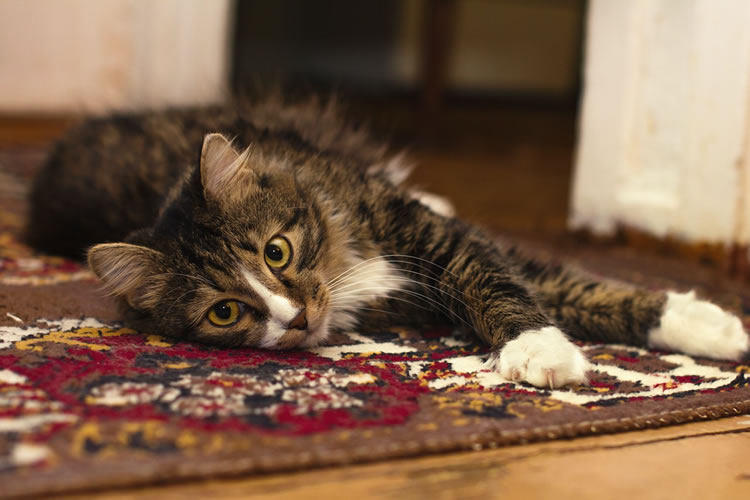
How to Get Cat or Dog Pee out of Carpet
We all love carpet, but it can be a nuisance to clean when your furry friend has had an accident. Here are some tips for getting rid of pet stains and smells on carpet:
- As noted under “Dos & Don’ts” above, always clean up dog or cat pee as soon as you possibly can — if you let it dry, cleanup will be much harder.
- When blotting up liquid, if the carpet in question is an area rug or otherwise can be lifted up, put a thick layer of paper towel under the carpet, as well as on top of it. Then stand on top of it, using your bodyweight to press out as much liquid as possible. This will help to keep it from soaking into the subfloor under the carpet.
- Once you’ve pressed out as much as you can, rinse the area with cool water, and then repeat the blot-and-press routine.
- Now it’s time to try and neutralize the scent. Read on for some techniques you can use for that… (See “4 Ways to Get Rid of Pet Urine Smell in Carpet or Flooring”, below.)
- And remember to test any cleaner you plan to use on an inconspicuous spot to make sure it doesn’t harm or discolour the carpet.
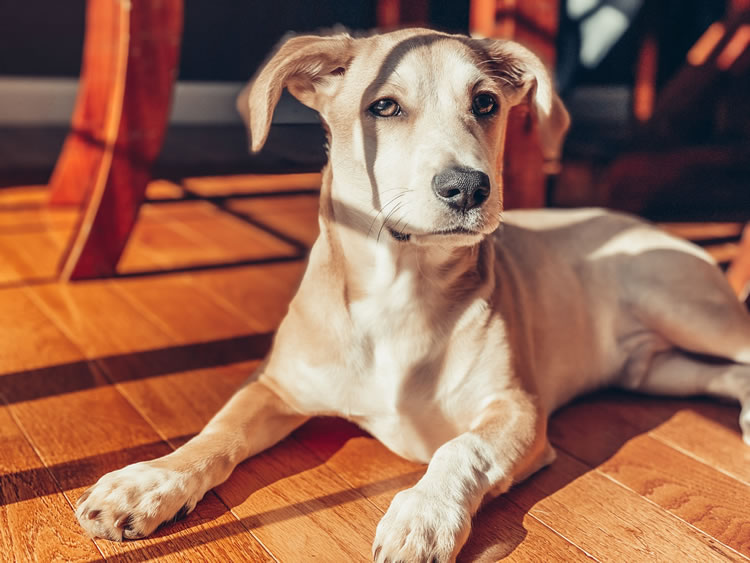
How to Get Cat or Dog Urine out of Hardwood Flooring
Like carpet, hardwood has its own quirks and vulnerabilities to pet accidents. Here are a few hardwood-specific tips:
- The most important thing is to be aware that hardwood floors (and, especially, many of the finishes used on them) can be damaged by moisture, so it is even more essential to blot up liquids very quickly.
- The same basic steps should be followed as for carpet, but be cautious with how much liquid you use, when rinsing with water, or treating with vinegar or peroxide. and be sure to dry the floor thoroughly afterward.
- Always test any cleaner you plan to use on an inconspicuous spot to make sure it doesn’t harm the finish of the hardwood.
- If you find there’s no way to get the scent out without harming the finish, or if the pet urine has already soaked in and damaged the finish, you may need to have the floor sanded down and refinished (see “When to Call the Professionals”, below).
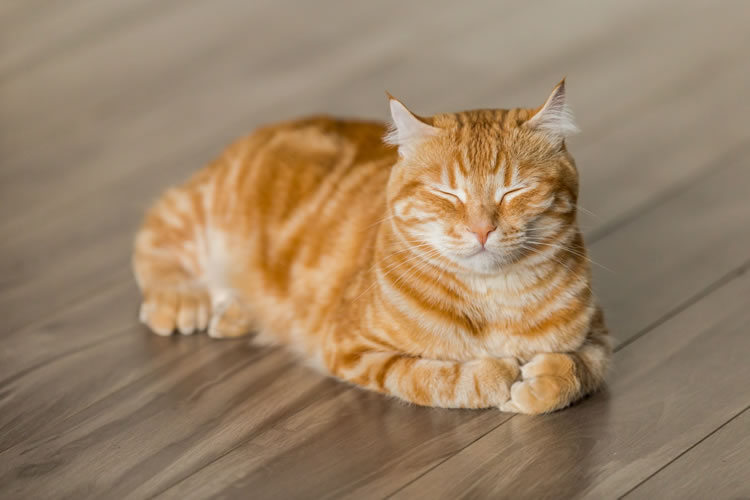
How to Clean Up Dog or Cat Pee on Other Types of Flooring
If your flooring is Marmoleum, vinyl, laminate, or limestone composite, you’re probably going to have an easier time of it. All these types of flooring are considerably more water-resistant than carpet or hardwood, and some are completely waterproof! However, a few things to keep in mind:
- Was your flooring applied in a solid sheet, or as individual planks or tiles? This can make a difference in how well it resists cat or dog pee (or any other liquid). Solid sheet flooring generally holds up very well to moisture, as it has no gaps, but with planks and tiles, it may be possible for liquids to seep down under the flooring, depending on how tightly they fit together.
- Some flooring manufacturers — notably Torlys, with their Bulldog tool — provide ways to lift out and replace a single plank or tile, which can be very helpful if liquid has leaked underneath it.
- If you suspect that the liquid has leaked underneath, see if it’s possible for you to lift the flooring. If you can, clean thoroughly underneath with diluted bleach (1 part bleach to 10 parts water), to prevent mold or fungi from growing.
- Important note: DO NOT use bleach if you've recently done a vinegar rinse — mixing vinegar and bleach produces a toxic gas! And make sure you've blotted up as much urine as possible before getting bleach anywhere near it, since even the small amount of ammonia in urine could react with the bleach to a minor extent. Having good ventilation when working with bleach is also important, as is keeping your pets out of the room.
- If you can’t lift the flooring, then you may need professional assistance (see “When to Call the Professionals”, below).
- If it doesn’t appear to have leaked underneath, then you can just clean up the liquid like you would any spill (which will be much easier than on carpet or hardwood!), and use one of the deodorizing methods below, though you likely won’t need anything as intensive as the peroxide method. A simple vinegar rinse or an enzyme cleaner should work well.
- Ceramic and (especially) porcelain tile are designed to be water resistant, and generally clean up with little difficulty. However, since the grout can be porous, you may want to apply some vinegar or an enzyme cleaner and let it sit for a short while, to get rid of any odours that may have seeped into the grout. But in general, tile is much less prone to stains and smells than most types of flooring.
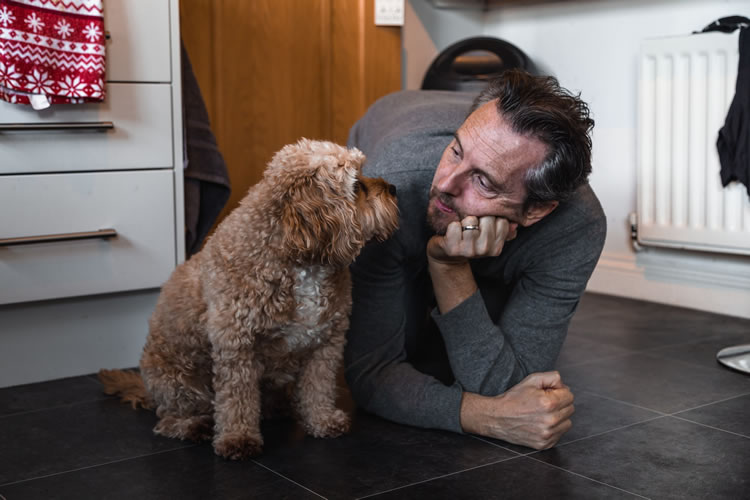
4 Ways to Get Rid of Dog or Cat Urine Smell in Carpet or Flooring
1. Vinegar Rinse
Vinegar neutralizes ammonia, which is one of the components of dog and (especially) cat pee, while baking soda is a good all-purpose deodorizer, and also neutralizes uric acid (another of the components of pet urine). But it’s best to use them one at a time rather than mixing them, or they’ll end up neutralizing each other instead!
One simple approach is to dampen the area with a 50/50 mix of vinegar and water, let it sit for at least 15 minutes, then blot up as much of it as possible with paper towels, like you did before. If you caught the accident early and it wasn’t too big, this may be enough on its own.
2. Baking Soda (Dry Technique)
This method is meant for use on dry carpet, after you’ve already done the blot-rinse-blot routine.
Cover the area with baking soda — use a generous amount to really cover it well. You may want to give it a rub with a dry sponge or brush to work it into the carpet fibres. Let it sit for several hours, or ideally overnight, then vacuum thoroughly.
3. Baking Soda (Wet Technique)
This is a little more intensive than the dry technique, so it’s a good one for persistent odours, or worse accidents (like when the pet accident was something other than pee — although at least solids are easier to remove!), where a little dry baking soda is unlikely to be enough. And peroxide is also an excellent disinfectant, making it especially good if you’re dealing with cat or dog poop rather than pee.
First rub baking soda into the spot as above, and let it sit for about 15 minutes. Then saturate the area with a mixture of 1 cup of 3% hydrogen peroxide (the kind they sell in the first aid aisle in drugstores) and 1 teaspoon dish detergent). This will likely foam up a lot due to the chemical reaction. Let it sit until it stops bubbling, then blot up (or use a wet vac if you have one), rinse, and blot again.
Note: Be sure to test this solution first in an inconspicuous spot! It may leach the colour from some types of carpet and flooring.
And an important safety note here: don't mix hydrogen peroxide with vinegar or bleach! If you've done a vinegar rinse and it didn't kill the smell, make sure you've rinsed the area with clean water and blotted up all moisture before applying anything containing peroxide. And make sure you've got good ventilation.
4. Enzyme-based Cleaners
If home remedies sound like too much work and you just want something readymade, there are a number of enzyme-based cleaners out there specifically formulated for pet messes (Nature’s Miracle is one good one — you can find it at almost any pet store). The enzymes they contain work to specifically neutralize the proteins in urine, and can be very effective.
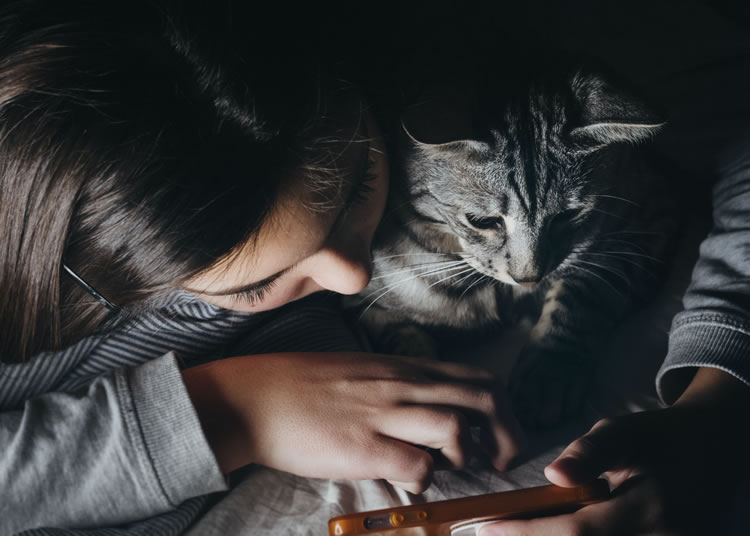
When to Call the Professionals
Sometimes, home remedies just aren’t enough, and you’re going to need some outside help. Here are some of the situations where you may need professional assistance:
- If you don’t discover the accident until long after it’s soaked in, and none of the techniques above seem to help.
- If the accident itself, or a cleaning product you’ve tried to use to deal with it, has damaged the finish in your hardwood floors.
- If you suspect the pet urine has seeped underneath your flooring, and you’re not able to lift the flooring yourself to deal with it. This goes double if you find the area of the accident starts feeling a little softer than the surrounding floor, as that may mean the wooden subfloor is damaged.
In any of these cases — or if you ever need your carpet or flooring repaired or replaced for any other reason — just give us a call at 416-698-8956 (landline) or 416-602-8956 (cell), or use the contact form below to get in touch, and we’ll be happy to help you out. We have extensive experience in installing and repairing carpet, hardwood, and every other type of flooring.

Looking for Pet-Friendly Flooring?
If you’re a pet owner who wants to avoid damage from pet accidents in the future, you may want to look into what kinds of carpet or flooring are most pet-friendly — meaning resistant to moisture damage, smells and stains. Which, as it happens, is the topic of our next blog post! And we've got lots more planned, so be sure to check back regularly, or follow us on social media to be the first to know whenever we have new info to share!
- Log in to post comments
